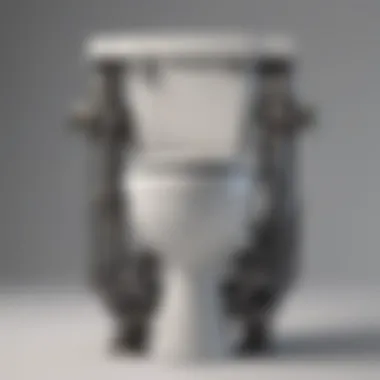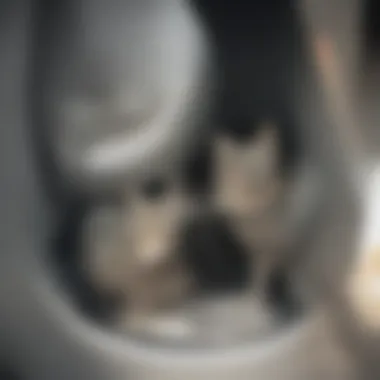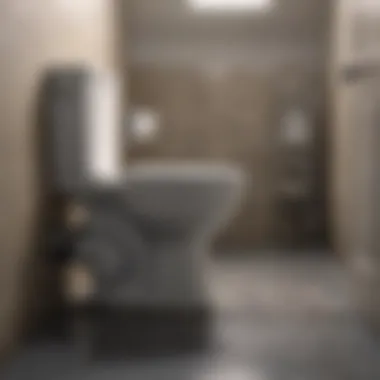Ultimate Guide to Toilet Trap Cleaning Techniques


Intro
Cleaning a toilet trap is a crucial but often overlooked maintenance task for homeowners. The toilet trap plays a significant role in ensuring the efficacy of bathroom plumbing by preventing sewer gases from entering the home. However, over time, it can accumulate waste and debris, leading to clogs and unpleasant odors. This guide aims to demystify the process of cleaning a toilet trap, emphasizing essential methods, tools, and preventive strategies to maintain optimal functionality.
Understanding the anatomy of a toilet trap helps in recognizing the importance of this component. It is generally the curved pipe located directly below the toilet bowl, designed to hold a small amount of water, creating a barrier to unwanted gases. Proper maintenance of the trap not only enhances hygiene but also prolongs the lifespan of the plumbing system.
In this comprehensive guide, we will explore how to effectively clean a toilet trap, addressing various problems that may arise over time, and providing actionable solutions.
The Importance of Maintaining a Toilet Trap
Maintaining a toilet trap is essential for several reasons.
- Prevention of odors: A clean trap ensures that unpleasant smells do not seep into the home.
- Avoiding clogs: Regular cleaning reduces the chances of buildup, which can cause toilet clogging.
- Prolonging plumbing life: Proper maintenance keeps the plumbing system functioning well, reducing future repair costs.
"Regular attention to toilet traps is a small effort that yields notable benefits in hygiene and comfort."
Understanding your toilet trap is the first step in successful maintenance. In the following sections, we will cover the methods and tools needed for cleaning a toilet trap, as well as preventive strategies to ensure ongoing performance.
Preamble to Toilet Traps
Toilet traps are often overlooked but play a crucial role in a home's plumbing system. Understanding their function and necessity brings to light why maintenance is essential. A toilet trap protects against foul odors and helps with proper waste disposal.
Definition and Functionality
A toilet trap is a curved pipe that holds a small amount of water. This water creates a seal that prevents sewage gases from entering the bathroom. When you flush the toilet, waste and water flow into the trap. The design of the trap ensures that the waste is directed towards the main sewer line, maintaining a hygienic environment. Without a functioning trap, unpleasant smells and unsanitary conditions can develop.
Common Issues Related to Toilet Traps
A variety of problems may arise with toilet traps. One common issue is clogging, which can occur due to excessive toilet paper, foreign objects, or mineral buildup. Slow drainage is another sign of a trap issue, resulting in waste not flowing effectively. In some cases, unpleasant odors may indicate that the trap water is evaporating, leading to a break in the seal. It’s essential to recognize these issues early to maintain the stability and cleanliness of the bathroom.
"A well-maintained toilet trap is essential for health and hygiene. Regular inspection is key."
Importance of Cleaning Toilet Traps
Cleaning toilet traps is more than just a routine household chore. It can directly impact health, hygiene, and the overall functionality of the bathroom plumbing system. Regular cleaning ensures that everything works properly while preventing costly repairs down the line.
Health and Hygiene Considerations
Health concerns arise from neglecting toilet traps. Over time, built-up debris creates a breeding ground for bacteria. This can lead to unpleasant odors and potential health risks such as infections and allergies. A clean toilet trap minimizes these risks and promotes a healthier environment at home.
Regular cleaning practices, such as using appropriate cleaning agents, can significantly reduce bacterial growth. These agents often contain disinfectants that kill germs effectively without the need for extensive scrubbing. Some homeowners may wonder how often to clean the traps. Generally, a deep clean every six months is a good standard, along with regular maintenance to keep the system functioning well.
Preventing Clogs and Blockages
Preventing clogs is another key reason to clean toilet traps. Accumulations of waste can prematurely age your plumbing system, leading to blockages that require professional intervention. A clogged toilet trap often results in slow draining, water backup, or even overflow incidents.
By performing regular cleanings, homeowners can effectively minimize the risk of blockages. This proactive approach saves time and money in contrast to dealing with repairs. Some effective practices include:
- Routine inspections: Check for any signs of slow drainage or odors, which may indicate trapped debris.
- Using baking soda and vinegar: These household items work well together to break down buildup without harmful chemicals.
- Avoiding flushing inappropriate items: Discouraging the disposal of non-flushable items can prevent potential clogs overall.


Maintaining a clean toilet trap is an investment in your home that pays dividends in improved plumbing performance and elevated hygiene.Cleaning is not merely a task; it’s a vital step toward a healthier and more functional home.
Tools Required for Cleaning
Cleaning a toilet trap efficiently necessitates the right tools. Having the proper equipment not only streamlines the process but also ensures that the task is conducted safely and thoroughly. Using inadequate tools can lead to frustration and ineffective cleaning, which may compound plumbing issues over time. This section will outline the basic cleaning supplies as well as specialized tools that can optimize the cleaning process.
Basic Cleaning Supplies
Basic cleaning supplies are fundamental to any toilet trap cleaning process. They serve as the first line of defense against grime and blockages. Below are essential items:
- Rubber Gloves: Protect your hands from harsh chemicals and bacteria.
- Scrub Brush: A sturdy scrub brush can remove buildup effectively. Choose one with stiff bristles for better results.
- Disinfectant: An effective disinfectant helps kill germs and sanitizes surfaces.
- Sponges: Use sponges to wipe down surfaces after scrubbing, ensuring a clean finish.
- Bucket: A bucket is useful for holding cleaning solutions or collecting debris.
- Paper Towels: For quick cleanup and drying of surfaces.
These basic items ensure that you are adequately prepared to tackle the task, aiding in both functionality and hygiene. Always remember to opt for eco-friendly cleaning agents if possible, as they are less harmful to the environment.
Specialized Tools
Specialized tools can make a significant difference in the efficiency and effectiveness of cleaning a toilet trap. While not every homeowner may possess them, investing in such tools can save time and effort in the long run. Here are the recommended specialized tools:
- Plumber's Snake: This tool is crucial for clearing stubborn clogs that a simple brush cannot reach. Its flexible design can navigate through bends in the plumbing.
- Auger: Similar to a plumber's snake, an auger is designed for more persistent blockages that require more force to dislodge.
- Pipe Inspection Camera: This advanced tool allows you to visually inspect the inside of the toilet trap. It can help identify areas clogged with debris or damage.
- Toilet Auger: A specialized tool for toilets, it effectively breaks up blockages within the toilet trap.
Having these specialized tools on hand can enhance your ability to manage unexpected issues, facilitating comprehensive maintenance of your toilet's plumbing system.
Step-by-Step Guide to Cleaning a Toilet Trap
Cleaning a toilet trap can seem daunting, but it is critical for maintaining a functional bathroom. A clean trap facilitates proper waste movement and reduces the likelihood of plumbing issues. Understanding the step-by-step process equips homeowners and DIY enthusiasts with the knowledge needed to address this common household maintenance task effectively.
Preparation and Safety Measures
Before you begin cleaning the toilet trap, it’s essential to take the right precautions. Make sure to wear rubber gloves to protect your hands from harsh chemicals and germs. Additionally, wearing safety glasses can shield your eyes from any splashing. Ensure the bathroom is well-ventilated by opening a window or turning on an exhaust fan to minimize exposure to fumes from cleaning agents.
Gather your supplies ahead of time. This should include:
- Plunger
- Wrench or pliers
- Cleaning brush
- Bucket
- Towels or rags
- Mild cleaning solution or bleach
- Water (for rinsing)
Draining the Toilet
To effectively clean the trap, you need to start by draining your toilet. Begin by turning off the water supply to the toilet. This is typically located on the wall behind the toilet. Once the supply is off, flush the toilet to empty the tank. Use a sponge or rag to absorb any remaining water in the bowl. It is crucial to have a completely dry area to work on to prevent water from leaking during the cleaning process.
Accessing the Trap
After draining, you must access the toilet trap. This usually involves removing the toilet from the floor. Unscrew the bolts that secure the toilet to the floor using your wrench or pliers. Carefully lift the toilet, and place it on a protective surface, such as towels or cardboard, to avoid damaging the ceramic. Make sure to keep the wax seal and bolts safe for reassembly later.
Cleaning Techniques
Now that you have access to the trap, you can begin cleaning. Inspect the trap for any buildup, debris, or blockages. Use a cleaning brush to scrub the interior walls. If the buildup is heavy, a mixture of mild cleaning solution and water can enhance the cleaning process.
Consider using a plumbing snake to reach deeper blockages. Insert the snake into the trap and twist it to break apart any stubborn clogs. If using a chemical cleaner, follow the instructions carefully and let it sit for the recommended time before rinsing out thoroughly with clean water.
Reassembling and Testing
Once cleaning is complete, reassemble everything carefully. Put the toilet back on its base, aligning it with the bolts. Tighten the nuts to secure it down, but do not over-tighten as this can crack the porcelain. Reconnect the water supply and turn it back on. After this, check for any leaks around the base of the toilet.


Finally, flush the toilet a few times to ensure normal operation. Listen for any unusual sounds or observe any slow drainage, which may indicate that some issues remain.
This systematic approach to cleaning a toilet trap ensures it functions optimally and reduces future plumbing problems. Armed with these steps, homeowners can manage their toilet maintenance confidently.
Preventative Maintenance for Toilet Traps
Preventative maintenance is crucial for ensuring the long-term functionality of toilet traps. It involves a range of practices designed to reduce the likelihood of clogs and breakdowns. By taking proactive steps, homeowners can avoid the hassle and cost associated with emergency repairs.
A well-maintained toilet trap plays a vital role in the overall plumbing system. It prevents unpleasant odors from backing up into the bathroom, ensures proper drainage, and protects the integrity of your plumbing. Focusing on preventative maintenance allows you to catch potential issues early, averting larger problems in the future.
Regular Inspection Practices
Regular inspections are essential for identifying potential issues with toilet traps. These check-ups should focus on several elements:
- Visual Examination: Look for signs of leaks exteriorly around the toilet. This can indicate a failing seal or possible cracks in the trap.
- Drainage check: Pay attention to how quickly water drains when flushing. Slow drainage can be an early indicator of a potential blockage.
- Odor Detection: Any unusual smells can suggest a problem. If you notice persistent odors, it may be time to inspect the trap more closely.
In addition to visual inspections, flushing the toilet while observing the drainage can highlight issues. It is advisable to do this routinely, perhaps every few months. Proactive measures ensure that small problems do not escalate into significant repairs.
Recommended Cleaning Schedule
Developing a cleaning schedule can significantly reduce the buildup of debris and bacteria in toilet traps. Regular cleaning helps maintain hygiene and functionality. Here are some recommended intervals and practices:
- Monthly Cleaning: Utilize a mixture of vinegar and baking soda. Pour one cup of each into the toilet bowl and let it sit for about 20 minutes before flushing.
- Quarterly Deep Cleanings: Every few months, perform a more thorough cleaning. This might include using a brush to clean along the trap.
- Annual Inspection: At least once a year, check the entire toilet setup. Look for any needed repairs or parts that may need replacing.
Establishing a reliable schedule for maintenance not only prolongs the life of the toilet trap but enhances the overall cleanliness of your restroom.
Regular cleaning and inspection can prevent serious plumbing issues and costly repairs in the future.
Signs Your Toilet Trap Needs Attention
Recognizing when your toilet trap requires care is essential for maintaining a functional bathroom. A well-maintained toilet trap ensures proper waste disposal and prevents potential plumbing disasters. Ignoring warning signs can lead to more significant issues that may require professional assistance. This section will examine the specific indicators that suggest your toilet trap may need attention.
Slow Drainage Indicators
One of the primary signs that your toilet trap may need cleaning is slow drainage. If the toilet bowl takes longer than normal to drain after flushing, it could be a clear signal of an obstruction within the trap. Slow drainage might not be limited to just the toilet. You could also notice other drains in the bathroom exhibiting similar behavior.
To pinpoint the cause, you may want to perform a simple test. When you flush the toilet, observe the water level in the bowl. If the water rises and slowly returns to normal, the trap may be partially blocked.
Regular monitoring of drainage speed should be a routine for homeowners. Early detection can prevent a complete blockage, saving you from extensive repairs later.
Unpleasant Odors
Unpleasant odors emanating from the toilet area can also suggest that the trap needs attention. Sometimes, waste and debris accumulate and begin to decompose in the trap, emitting unpleasant smells. You may notice a foul scent that persists even after thorough cleaning.
This smell may be due to trapped organic matter that has not been cleared for some time. If the scent becomes more pronounced after using the toilet, it is crucial to investigate further. Maintaining hygiene is key; addressing this issue promptly can prevent the odors from permeating your living space.
Gurgling Sounds
Gurgling sounds during or after flushing can indicate trouble within your toilet trap. The noise suggests that air is trying to escape but is being hindered by a blockage. This can lead to pressure build-up, which ultimately compromises the efficiency of your plumbing system.
It is important to pay attention to the frequency of these sounds. Occasional gurgling may not be a major concern, but if it becomes consistent, further investigation is necessary. This is especially true if gurgling accompanies slow drainage or unpleasant odors.


A combination of these signs should not be ignored. Addressing them early can help maintain a healthy plumbing system, and save you from costly repairs.
Expert Tips for Effective Trap Maintenance
Maintaining a toilet trap is not just about cleaning; it is also about adopting practices that can enhance its lifespan and functionality. Adopting expert tips ensures that the trap remains effective, thereby preventing common plumbing issues. A well-maintained toilet trap facilitates proper drainage and minimizes odors, which are beneficial for both hygiene and comfort. Expert suggestions can range from cleaning methods to preventative practices.
Using Eco-Friendly Cleaning Solutions
Choosing eco-friendly cleaning solutions can be beneficial for both the environment and the integrity of plumbing systems. Chemical cleaners can be harsh, sometimes damaging pipes and other plumbing fixtures. Instead, consider natural alternatives such as vinegar or baking soda combined with hot water. These solutions, while effective, are safer for plumbing and less harmful to the environment.
- Vinegar: It helps break down mineral deposits and removes odors.
- Baking Soda: Excellent for neutralizing smells and providing mild abrasiveness for scrubbing.
- Hot Water: Can aid in dissolving residue effectively without the risk of damage.
This approach to cleaning truly reflects a mindful awareness of ecological impact while still addressing the core needs of toilet maintenance.
Avoiding Common Mistakes
Even when cleaning a toilet trap, several common mistakes can undermine your efforts. Being aware of these errors helps in maintaining the trap effectively over time.
- Neglecting Regular Maintenance: Many think cleaning is only needed when problems arise. Regular checks are essential to avoid buildup.
- Using Excessive Force When Scrubbing: While it is important to remove buildup, scrubbing too hard can scratch the surfaces and create grooves that trap more debris later.
- Ignoring Signs of Trouble: If there are persistent odors or slow drainages, ignoring these symptoms may lead to larger issues.
By addressing these mistakes proactively, you can maintain a well-functioning trap and avoid costly plumbing repairs later.
Effective trap maintenance not only ensures hygiene but also improves overall plumbing performance.
When to Call a Professional
As a homeowner, there comes a point when your ability to tackle plumbing issues hits a limit. Knowing when to call a professional plumber is crucial for preserving the integrity of your plumbing system and ensuring your home remains in good condition. Professional assistance can save time and resources and prevent complications that might arise from amateur fixes. This section will explore specific indicators that suggest a need for professional intervention, as well as guidance on finding a qualified plumber.
Identifying Serious Issues
Certain problems are indicative of deeper issues that might lie beyond your DIY capacity. Some of the signs include:
- Repeated Clogs: Frequent clogs can signify a significant blockage deep within the plumbing system. If your toilet keeps clogging despite regular cleaning, it may indicate a more severe obstruction in the trap or beyond.
- Water Backflow: If you notice water or waste flowing back into the toilet or other areas, this could indicate a serious problem with the plumbing system. Ignoring this issue could lead to significant hygiene concerns.
- Structural Damage: Dampness around the base of the toilet or visible leaks suggest that plumbing issues could damage flooring or structural components. Often, this necessitates thorough inspection by a professional to prevent further damage.
- Unusual Sounds or Smells: Gurgling noises or foul odors could indicate airflow problems or biohazard concerns, respectively. These signs should not be overlooked and warrant immediate professional assessment.
Choosing the Right Plumber
When the time comes to hire a plumber, consider factors that ensure you find a qualified professional. It's important to follow these steps:
- Check Credentials: Look for licenses, certifications, and insurance. These indicate that the plumber is qualified and adheres to industry standards.
- Read Reviews: Online reviews provide insight into the plumber's reputation and customer service. Websites like Reddit or local Facebook groups can offer valuable recommendations or warnings about specific professionals.
- Get Multiple Quotes: Contacting several plumbers for estimates allows you to compare pricing and gauge their professionalism. Be wary of prices that seem too low, as they may indicate subpar service.
- Discuss Experience: Ask about their experience with specific plumbing issues similar to yours. Experienced plumbers can often identify problems quickly and suggest effective solutions.
- Warranty and Guarantees: A good plumber will offer warranties for their work. This ensures you receive high-quality service and protects you against potential future issues.
Remember, putting off professional help could lead to escalated problems. When unsure, it's always better to consult with an expert.
Culmination
Cleaning a toilet trap is an essential task that often gets overlooked in household maintenance. Its significance transcends mere hygiene; it affects the overall functionality of your plumbing system. Regular maintenance of the trap can prevent severe issues like clogs or even complete pipe failure.
Summary of Key Points
In this article, we explored various aspects related to cleaning a toilet trap:
- Definition and Functionality: Understanding what a toilet trap is and how it operates is crucial for effective cleaning.
- Common Issues: We highlighted problems such as odors, slow drainage, and gurgling sounds that signal the need for attention.
- Tools Required: From basic cleaning supplies to specialized tools, knowing what you need is essential.
- Step-by-Step Process: Detailed instructions from preparation to testing ensure you approach the cleaning methodically.
- Preventative Maintenance: Regular inspections and a recommended cleaning schedule help maintain optimal function.
- Expert Tips: This includes eco-friendly cleaning solutions and avoiding common mistakes when cleaning.
- Professional Help: Recognizing when to call a plumber is vital to prevent worsening conditions.
Final Thoughts on Toilet Maintenance
Ultimately, focusing on toilet trap maintenance contributes to a healthier home. It is about prevention and sustainability. By understanding the mechanics and importance of the toilet trap, homeowners can take proactive steps to avoid costly repairs in the future. Regular cleaning not only ensures good hygiene but also enhances the bathroom's comfort and efficiency.
Following the guidelines outlined will position you to mitigate potential plumbing disasters, making maintaince straightforward and effective.







